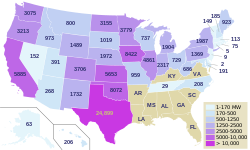In 2016, Arizona had 268 megawatts (MW) of wind powered electricity generating capacity, producing 0.5% of in-state generated electricity. [1]
In 2016, Arizona had 268 megawatts (MW) of wind powered electricity generating capacity, producing 0.5% of in-state generated electricity. [1]
Utility-scale wind power in Arizona began in 2009 with the commissioning of the first phase of the Dry Lake Wind Power Project [2] [3] in Navajo County.
The following table compares the growth in wind power installed nameplate capacity in megawatts (MW) for Arizona and the entire United States since 2008. [3] [4] [5]
|  |  | |||||||||||||||||||||||||||||||||||||||||||||||||||
Arizona has the potential to install up to 10.9 GW of onshore wind power nameplate capacity at 80 meter, 74.4 GW at 110 meter, or 191.0 GW at 140 meter hub height, generating 585 TWh annually. [6] [7] [8] For comparison, Arizona consumed 69.391 TWh of electricity in 2005; [9] [10] the entire U.S. wind power industry was producing at an annual rate of approximately 50 TWh at the end of 2008; Arizona's Palo Verde Nuclear Generating Station produced 26.782 TWh in 2007; and Three Gorges Dam (the world's largest electricity-generating station) produced an average of 80 TWh/yr in 2008 and 2009.

Flagstaff is the home of Southwest Windpower.
The ASU School of Sustainability in Tempe, Arizona features an array of small wind turbines on its roof, with real-time data available to the public through the ASU Campus Metabolism [24] web site.
According to the USDOE, each 1000 MW of wind power capacity installed in Arizona will annually save 818 million gallons of water and eliminate 2.0 million tons of carbon dioxide emissions. [25]
For comparison, Arizona emitted a total of 101,510,000 tonnes of carbon dioxide in 2007. [26]
| Arizona Wind Generation (GWh, Million kWh) | |||||||||||||
|---|---|---|---|---|---|---|---|---|---|---|---|---|---|
| Year | Total | Jan | Feb | Mar | Apr | May | Jun | Jul | Aug | Sep | Oct | Nov | Dec |
| 2009 | 30 | 12 | 8 | 10 | |||||||||
| 2010 | 136 | 6 | 7 | 15 | 14 | 18 | 12 | 7 | 6 | 6 | 9 | 13 | 23 |
| 2011 | 255 | 9 | 27 | 31 | 38 | 34 | 33 | 13 | 11 | 9 | 14 | 26 | 10 |
| 2012 | 532 | 47 | 47 | 61 | 51 | 59 | 52 | 34 | 30 | 30 | 41 | 32 | 48 |
| 2013 | 450 | 31 | 35 | 45 | 55 | 60 | 49 | 24 | 18 | 30 | 41 | 27 | 35 |
| 2014 | 467 | 28 | 36 | 43 | 58 | 63 | 62 | 26 | 25 | 23 | 21 | 53 | 29 |
| 2015 | 451 | 16 | 35 | 31 | 53 | 44 | 34 | 32 | 29 | 31 | 35 | 56 | 55 |
| 2016 | 542 | 42 | 38 | 56 | 50 | 55 | 46 | 46 | 21 | 44 | 51 | 44 | 49 |
| 2017 | 570 | 53 | 52 | 54 | 54 | 52 | 39 | 32 | 35 | 36 | 55 | 52 | 56 |
| 2018 | 528 | 47 | 43 | 55 | 55 | 41 | 45 | 36 | 38 | 38 | 40 | 44 | 46 |
| 2019 | 555 | 48 | 47 | 47 | 50 | 46 | 42 | 43 | 39 | 49 | 48 | 48 | 48 |
| 2020 | 643 | 43 | 42 | 59 | 52 | 54 | 60 | 34 | 35 | 31 | 31 | 84 | 118 |
| 2021 | 1,600 | 126 | 132 | 166 | 157 | 153 | 137 | 111 | 131 | 99 | 123 | 108 | 157 |
| 2022 | 1,565 | 106 | 150 | 156 | 185 | 186 | 156 | 119 | 63 | 101 | 76 | 153 | 114 |
| 2023 | 1,733 | 159 | 145 | 180 | 121 | 155 | 152 | 180 | 120 | 147 | 147 | 149 | 77 |
| 2024 | 1,923 | 126 | 195 | 221 | 191 | 274 | 268 | 218 | 236 | 185 | . | . | |